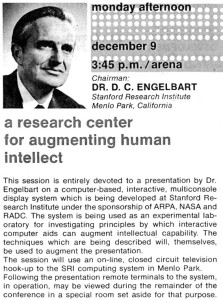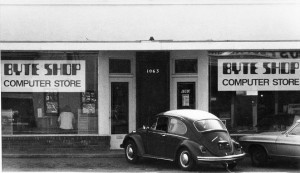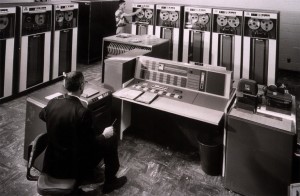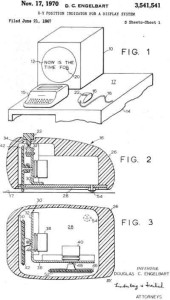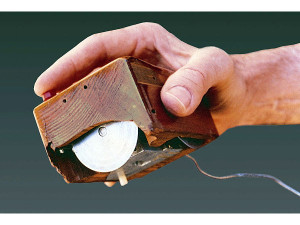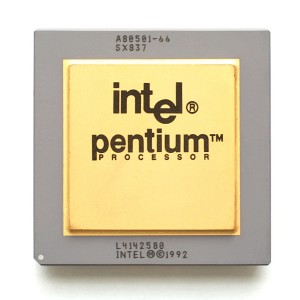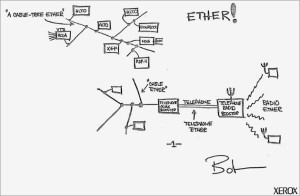Computers
A Worm For Christmas?
The Christmas Tree Worm begins to affect IBM mainframe computers around the world. The worm was delivered by e-mail and drew a Christmas tree text graphic on the user’s monitor and searched out other network users to e-mail. Named CHRISTMA EXEC because IBM systems only supported eight-character filenames, it was the world’s first widely disruptive computer worm. While the worm was not intentionally destructive, the volume of e-mails it created could disrupt a user’s work and began to overload e-mail systems. It reached IBM’s VNet e-mail network on December 15th and two days later had crippled it to the point they had to shut it down to eradicate the worm.
Douglas Englebart Demos the “Mouse”
Douglas Englebart and his team of researchers present a 90-minute public technology demonstration including such innovations as hypertext, video conferencing, and most famously, the computer mouse. This is the first public demonstration of the mouse, witnessed by about 1,000 computer professionals in attendance.
The Byte Shop Opens
Paul Terrell opens the Byte Shop in Mountain View, California, one of the first retail computer stores in the world. Besides that important distinction, Paul Terrell and the Byte Shop are most famously known for ordering the first 50 computers from Steve Jobs and Steve Wozniak’s fledgling Apple Computer company in 1976. As the story goes, the Steves initially intended the Apple I to be a kit, where buyers would solder together the chips onto the circuit board themselves. Terrell requested that instead they deliver fully-assembled computers as he was having trouble selling other kits to people who couldn’t put them together themselves. By insisting on a fully-assembled computer (even though the Apple I still lacked a case, power supply, and keyboard), Terrell helped shape the future direction of Apple and the entire personal computer industry. The Apple II was the first personal computer to be manufactured and sold as completely assembled units, making them accessible to the average user, thus igniting the personal computer revolution.
Apple Releases QuickTime
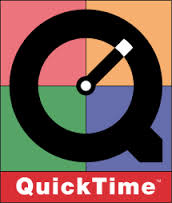 December 2, 1991
December 2, 1991
Apple releases version 1.0 of QuickTime, a multimedia extension for playing color video, transforming the capabilities of personal computers. Before QuickTime, only specialized computers could play color video. QuickTime allowed anyone with a personal computer to do so and it changed the history of computing – in more ways than one. It was the patent infringement battle over QuickTime that led to the now-famous truce between Steve Jobs and Bill Gates in 1997 that helped Apple survive long enough to transform itself in the 2000’s.
IBM 7090 Delivered
IBM delivers the first two IBM 7090 mainframe computers. One of the first commercially produced fully-transistorized computers, the 7090 and the later 7094 were notable for being used by NASA to control the Mercury and Gemini space flights along with many other significant scientific and government applications in the 1960’s. Some 7090’s were even used through the 1970’s into the 1980’s.
Altair 8800 Featured in Popular Electronics
November 29, 1974
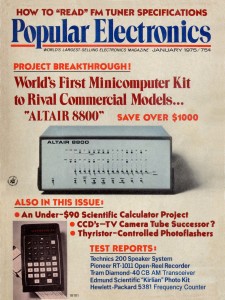
The story behind the collaboration of MITS and Popular Electronics for this particular issue is interesting. The recently hired editor of the magazine wanted more computer projects to be featured yet knew that existing microcomputer projects of the time were somewhat daunting for hobbyists to complete. They were looking for something that was a complete kit in a professional-looking enclosure. Another editor knew that MITS was working on a project that could fit their need and collaborated with them to have the kit ready for the January issue publication. While the first prototype was ready in October and was shipped to Popular Electronics, it never reached them due to either a strike by the shipping company or simply being lost or stolen (the story varies depending on the source). The article was actually written using pictures of an empty mock-up of the Altair and a prototype circuit board layout that was different than the finished product. Additionally, MITS left the naming of the microcomputer kit to the magazine. One of the editors claims that the inspiration for the name came from this 12-year old daughter who suggested calling it Altair after the location where the Star Trek Enterprise would be traveling in that night’s episode. However, other sources claim it was a technical editor of the magazine who came up with Altair when it was suggested the computer be named after a star. Whatever the truth is, the Altair 8800 was one of the most important computers in technology history and we all owe a great deal to this particular magazine issue for publicizing it.
Computer Mouse Patented
Douglas Engelbart receives US patent 3,541,541 for his “X-Y Position Indicator For A Display System”, more commonly known as the computer mouse. Engelbart called his device a “mouse” because the cord looked like a tail. The mouse was first prototyped in 1964, but wasn’t demoed until 1968, and was not included with a commercial computer until the Xerox 8010 Star Information System in 1981. Apple first brought the mouse to a personal computer with the Lisa in 1983. However the mouse did not become ubiquitous until after 1984, when Apple’s Macintosh popularized the device.
The Dawn of the Microprocessor
An advertisement in the magazine Electronic News announces the Intel 4004, the first commercially available microprocessor. The 4004 was primarily used in calculators, the first being the Busicom 141-PF. In fact, it was Busicom that actually developed the design of what would become the Intel 4004. Busicom approached Intel to help them finalize the design and manufacture their “calculator engine”. Intel’s engineers reduced the 12 integrated circuit design Busicom had come up with to 4 ICs and delivered the finished product in January 1971. Busicom had exclusive rights to that design until later in that year, when Busicom and Intel renegotiated their contract with Intel lowering their prices to Busicom in exchange for rights to the design of the microprocessor.
By offering the first general-purpose programmable processor to the general market, Intel spurred the rapid development of electronic devices in the 1970s, culminating in the development of personal computers during that decade. However, Intel wasn’t the clear leader in the microprocessor market until the IBM PC and clones helped catapult Intel to that title in the 1980’s.
Intel Bugs Out
One week after reports surfaced identifying a flaw in certain Pentium processors, Intel releases a software workaround for operating systems to avoid the commonly named “F0 bug“. A very specific invalid operation passed to the affected processors would cause the processor to lock up, causing the computer and any software running on it to freeze. Identified by Intel as the “Invalid Operand with Locked Compare Exchange 8Byte (CMPXCHG8B) Instruction Erratum” (seriously?), the flaw, while potentially a serious problem, was practically little more than a PR headache as the invalid operation that triggered the processor to lock up was never encountered in real-world operations. Additionally, the F0 bug only affected the older Pentium processors, not the Pentium II and Pentium Pro processors Intel was currently shipping at the time. However, the workaround was necessary as malicious software could have exploited the flaw and caused serious problems for PCs and servers using the affected processors.
Ethernet is Born
November 11, 1973
As invented by Robert Metcalfe and David Boggs, an Ethernet network functions for the first time. From it’s humble beginnings as a research project at Xerox PARC, Ethernet has developed into the de facto standard for business and home networking.


